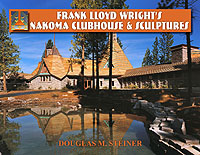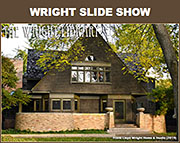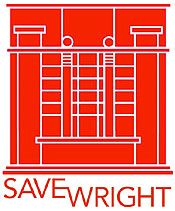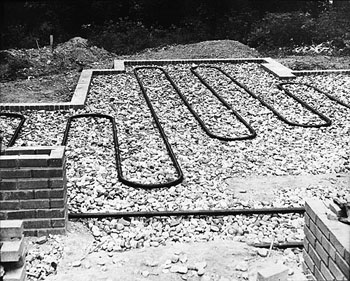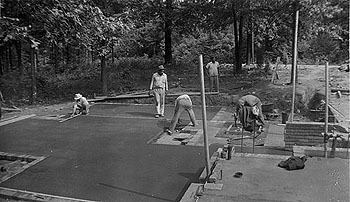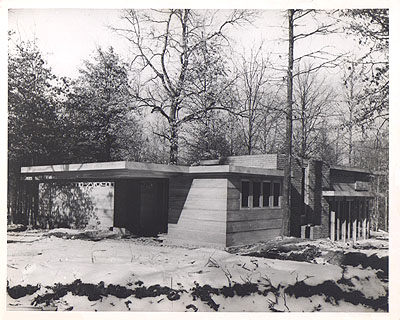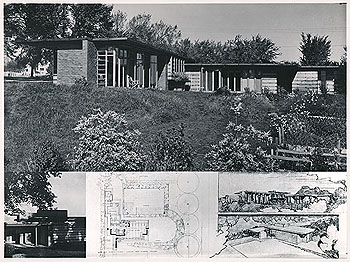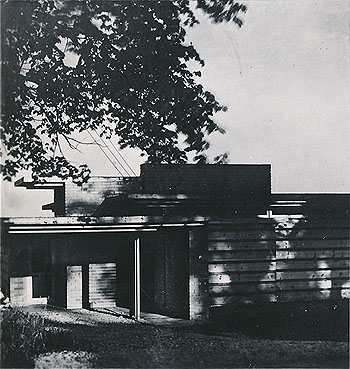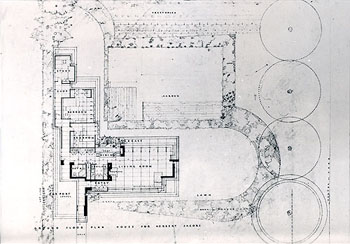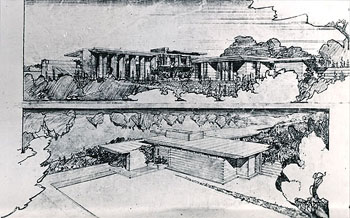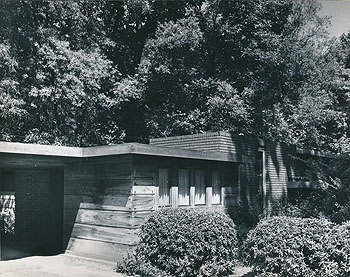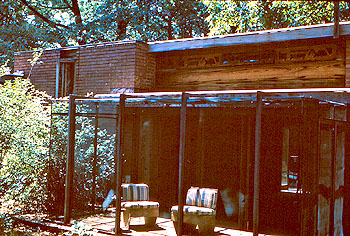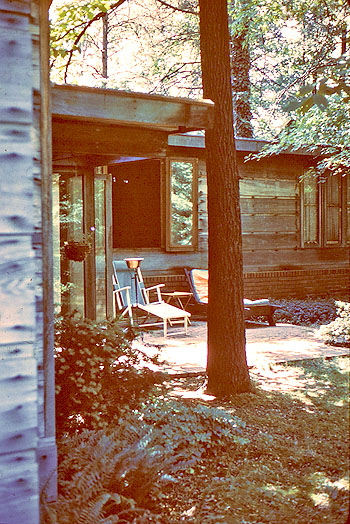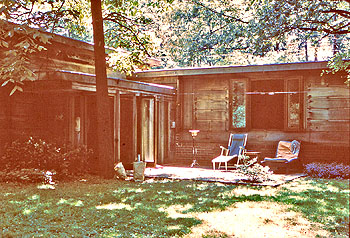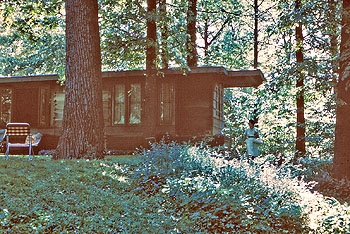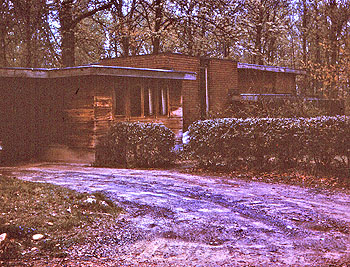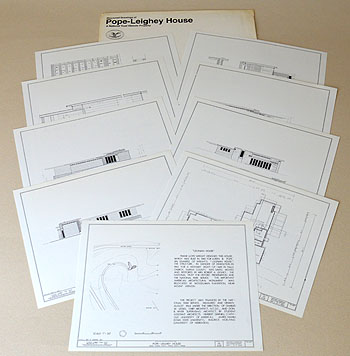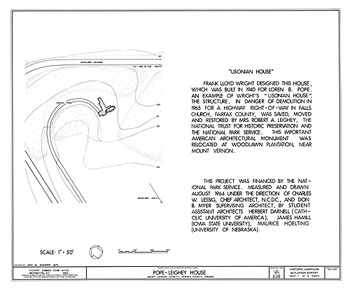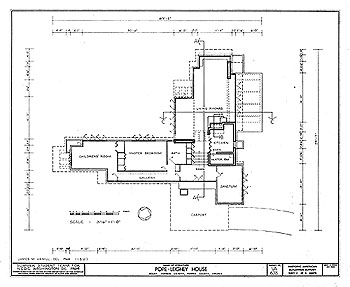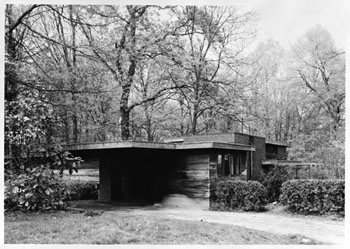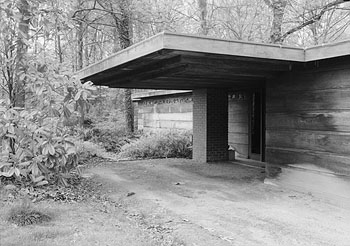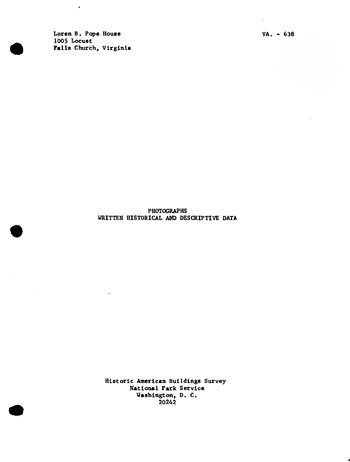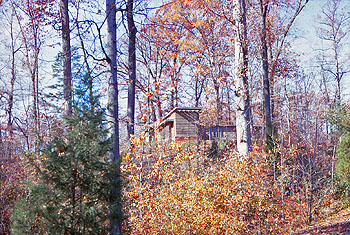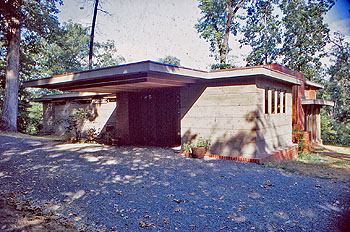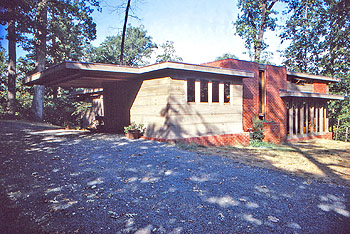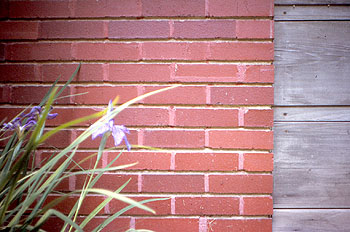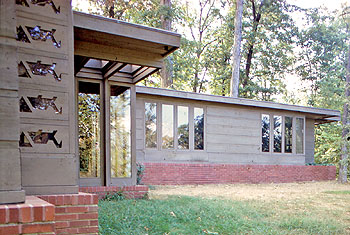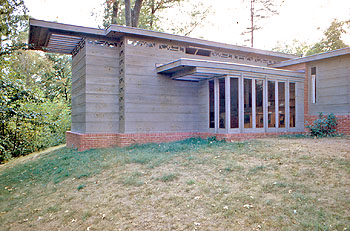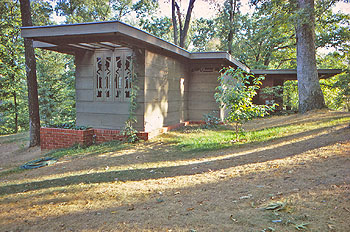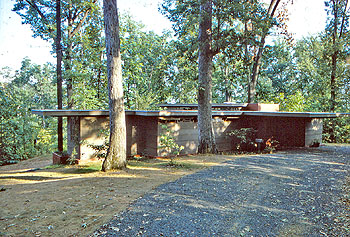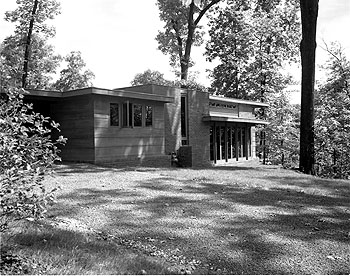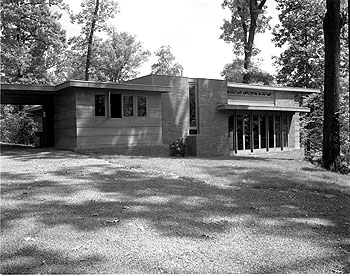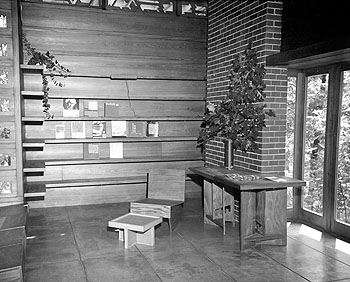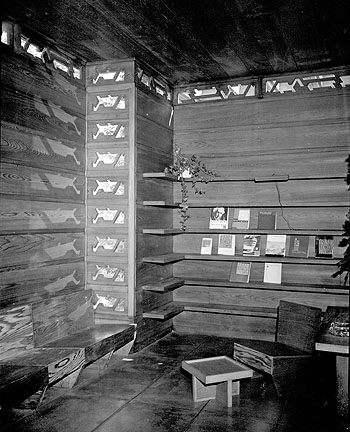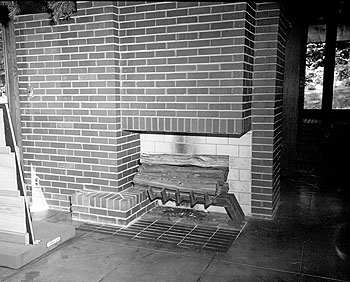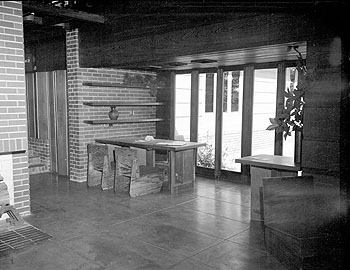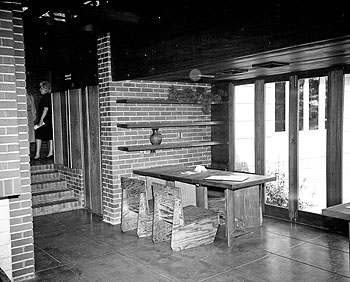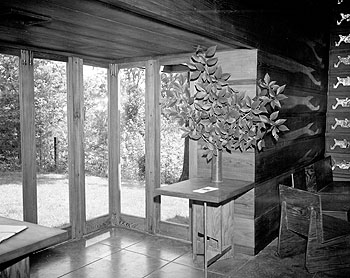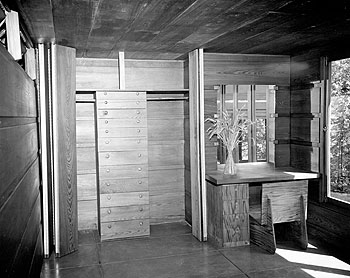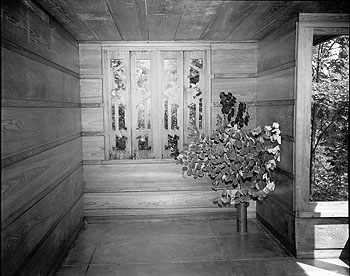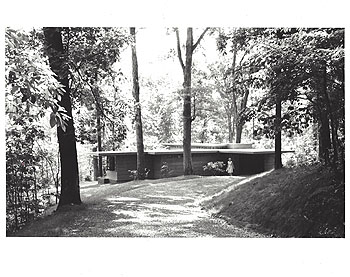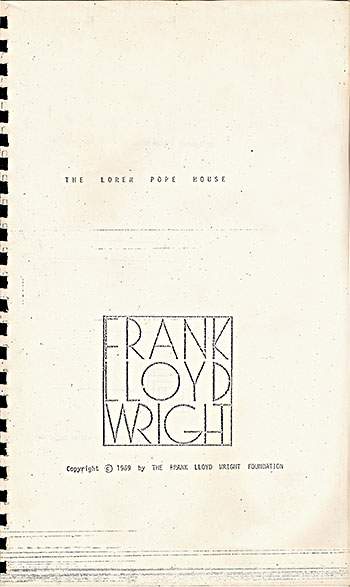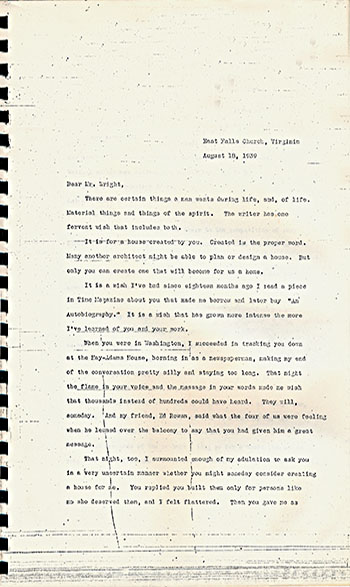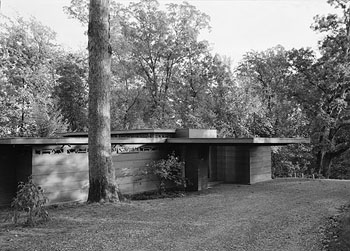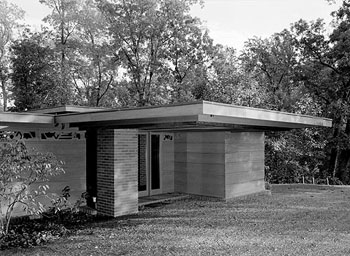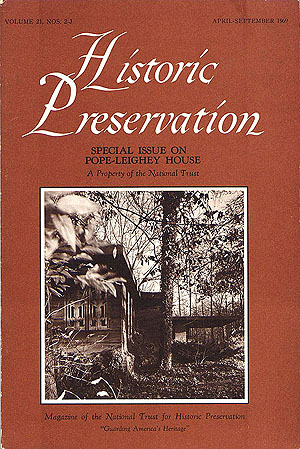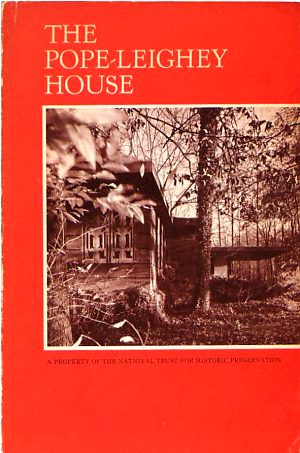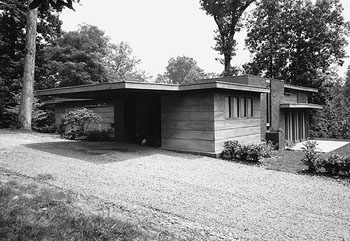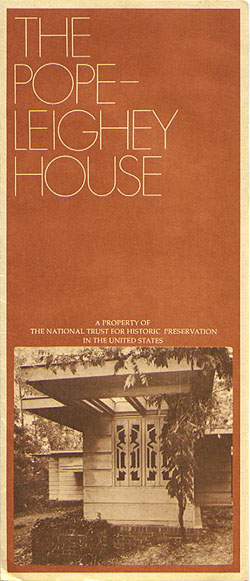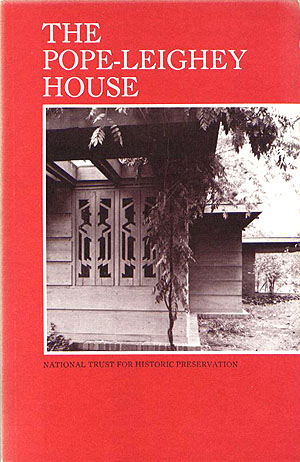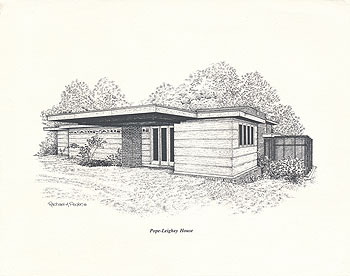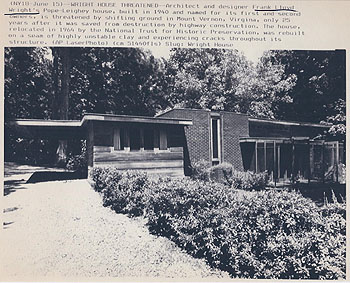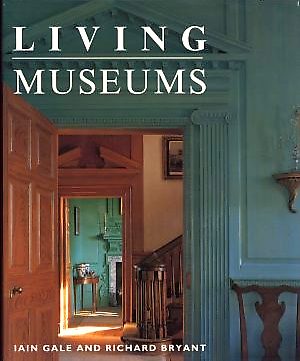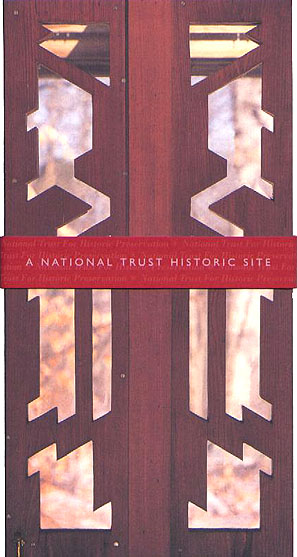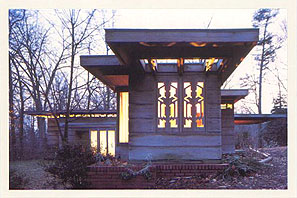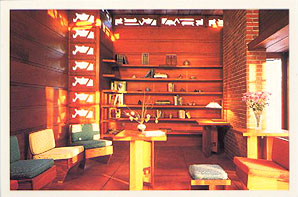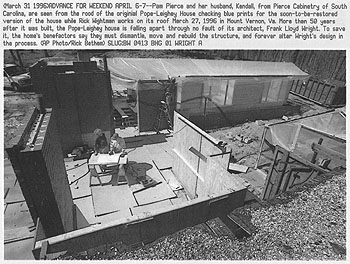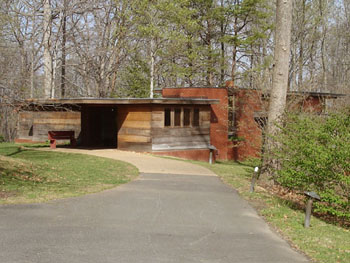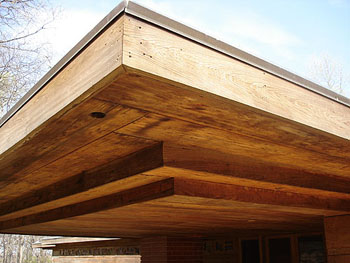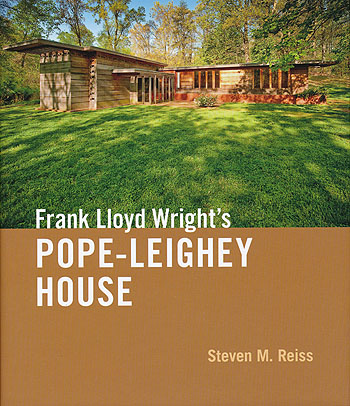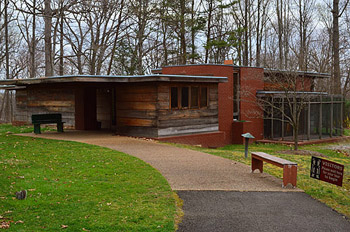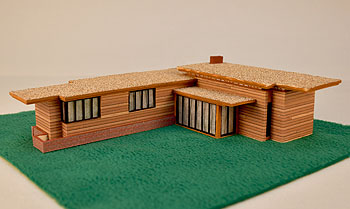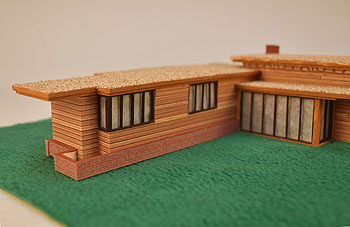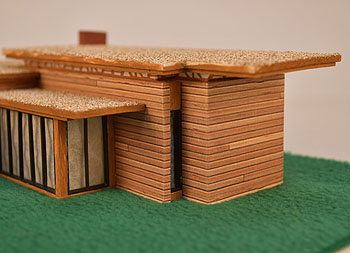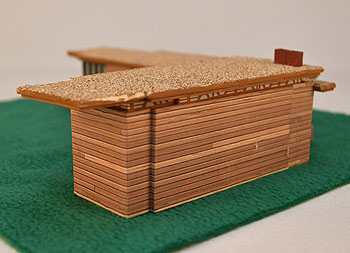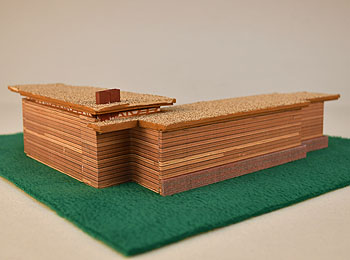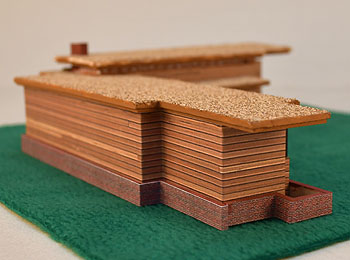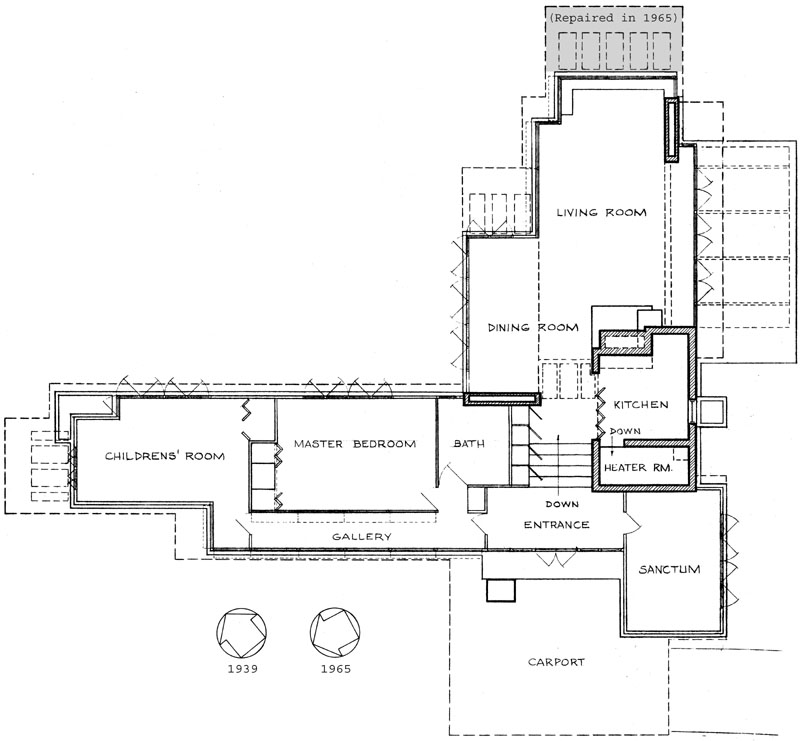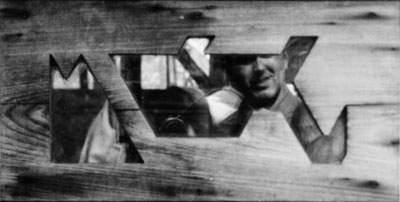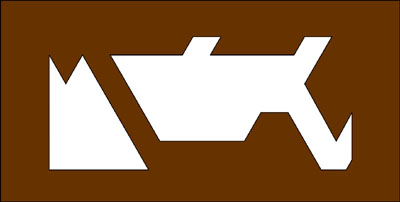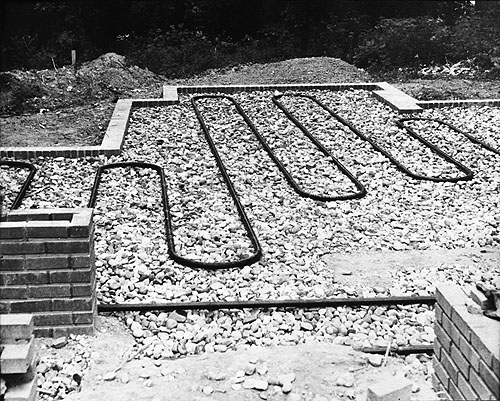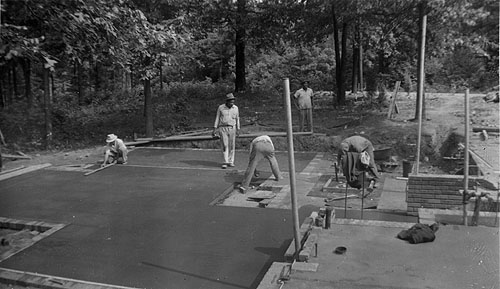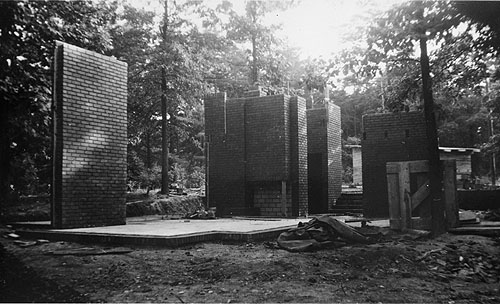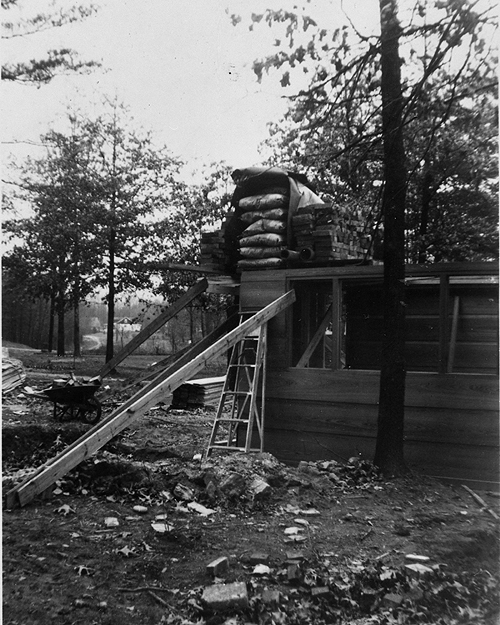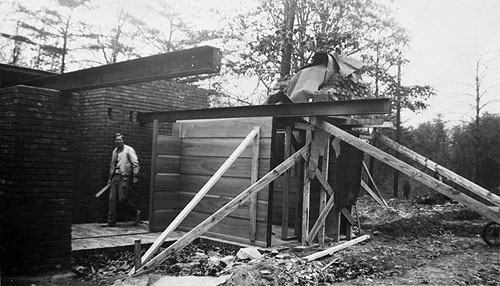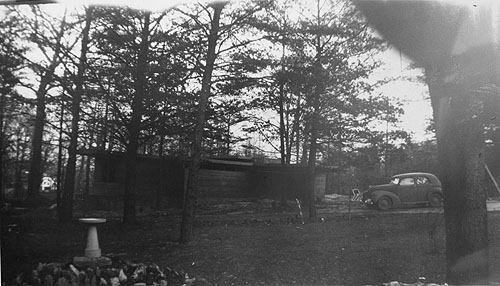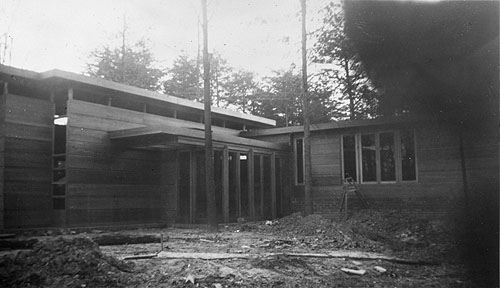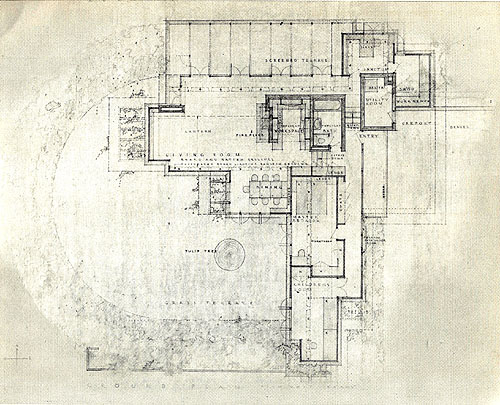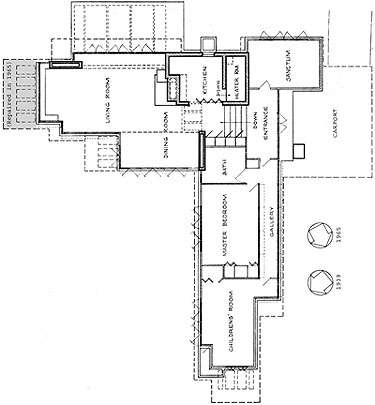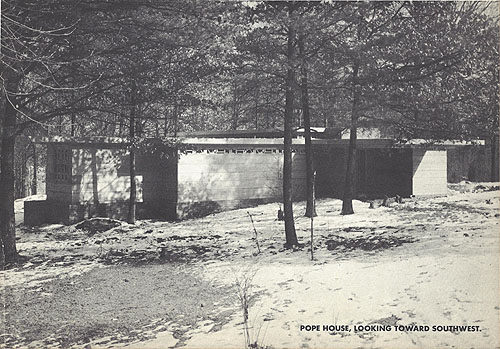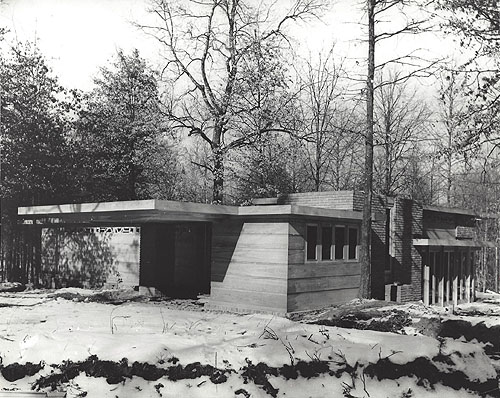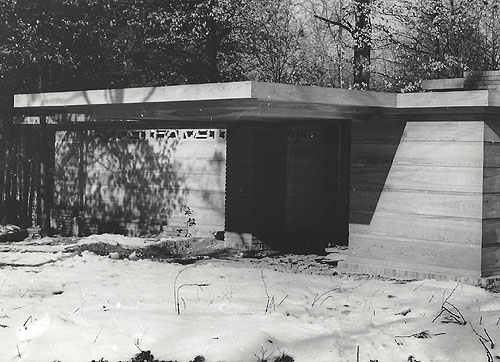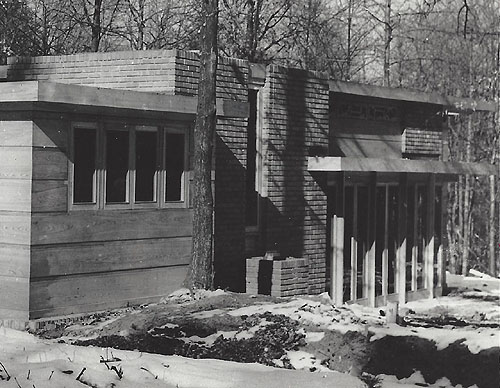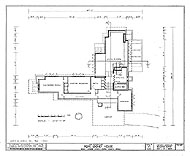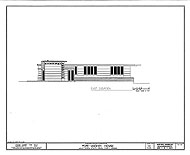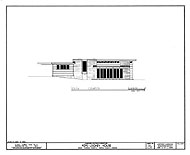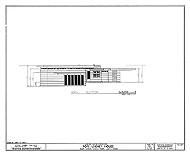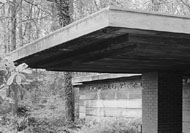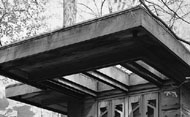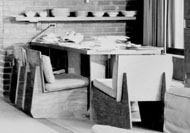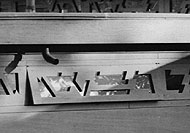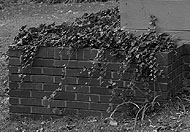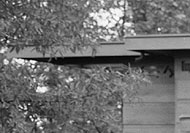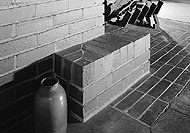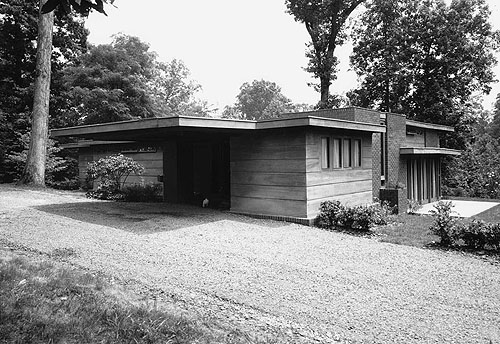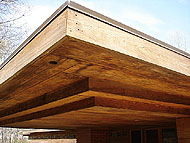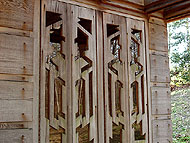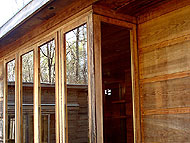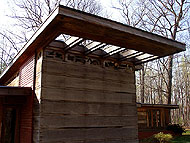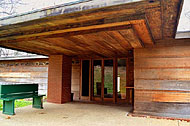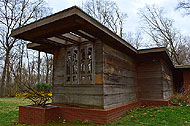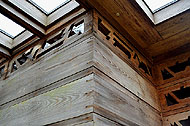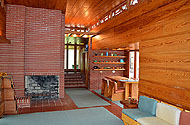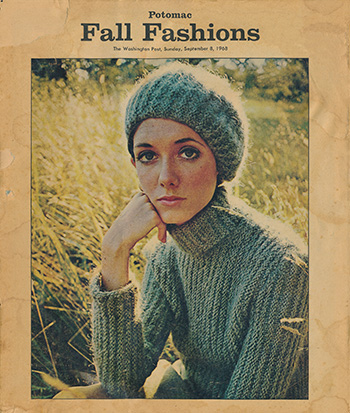
SUPPORT THE
WRIGHT LIBRARY
PROCEEDS FROM EVERY SALE GOES TO SUPPORT THE WRIGHT LIBRARY.
CLICK TO ORDER.
WE PROUDLY SUPPORT THE FRANK LLOYD WRIGHT FOUNDATION
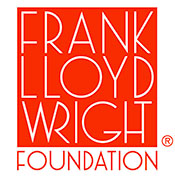
WE PROUDLY SUPPORT THE FRANK LLOYD WRIGHT BUILDING CONSERVANCY
WE PROUDLY SUPPORT FALLINGWATER
AND THE WESTERN PENNSYLVANIA CONSERVANCY
LOREN B. POPE (POPE-LEIGHEY) RESIDENCE (1939 - S.268) WRIGHT STUDY Introduction Floor Plan Perforated Light Screen Photographs (1940) The Natural House (1954)
Drawings HABS (1964) Photographs (1964) Photographs (1969) Photographs (1970) Photographs (2006)
Photographs (2015) Bibliography POTOMAC MAGAZINEDate: 1940 Title: Pope-Leighey House during construction, 1940
Description: This set of seven historic photographs of the Pope-Leighey House were taken during construction by Loren Pope in 1940. Preliminary sketches were completed in October 1939. Construction began in May 1940, with Taliesin apprentice Gordon Chadwick overseeing the project. The house was completed during the early part of 1941. Photographed by Loren Pope. Courtesy of the William Edmund Barrett collection... Continue, additional images...
Size: 10 x 8 B&W photographs.
S#: 0531.47.0815 1-7
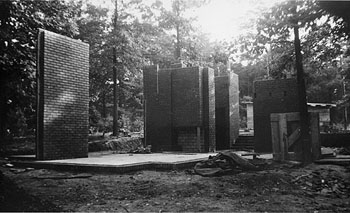
Continue, additional images...Date: Circa 1941 Title: Loren B. Pope Residence (1939)
Description: Photographed by Hedrich-Blessing (Ken & Bill Hedrich, Henry Blessing). This is the actual print that was used for producing the photograph in “The Natural House” 1954 Frank Lloyd Wright page 146. Also published in May 1964 Architectural Forum page 7.
Size: Original circa 1941 8 x 10 gelatin silver photo, by Hedrich-Blessing.
ST#: 0998.01.0706
Date: 1951
Title: Sixty Years of Living Architecture, Palazzo Strozzi, Florence, 1951.
Description: Display #57: "Jacobs House, Madison, Wisc., 1937. Cost in 1937, $5,500." Perspective, detail and three illustrations. Part of a set of forty B&W photographs by Ancillotti & Co., of the exhibition "Sixty Years of Living Architecture" held in Florence, Italy, 1951. "Sixty Years of Living Architecture: The Work of Frank Lloyd Wright" was a traveling exhibition of Wright's work, consisting of models, large photographs and original drawings. A Preview of the exhibition was held in Philadelphia at Gimbel Brothers Gallery in January, 1951. The world wide tour opened in Palazzo Strozzi Florence, Italy in June, 1951. Ancillotti & Company photographed many of the models and also documented the large photographs that were on display. Published in Sixty Years of Living Architecture: The Work of Frank Lloyd Wright, Moser, 1952, p.48.
Size: Original 9 x 7.25 B&W photograph.
S#: 0857.51.0221 -14
Date: Circa 1955
Title: Loren B. Pope Residence, Falls Church, Va. Circa 1955 (1939 - S.268).
Description: View of the Pope Residence from the South. Designed by Frank Lloyd Wright in 1939. Mounted to gray board. Label pasted to board: "Arch. U.S.A. 20th cent. Frank Lloyd Wright. Res. Loren Pope, Falls Church, Va. (1940). Wayne Andrews #1941. Indiana University, Fine Arts Department." Photographed by Wayne Andrews. Acquired from the archives of the Indiana University.
Size: Original 9.5 x 7.5 B&W Photograph.
S#: 1092.168.0920Date: Circa 1959
Title: Loren B. Pope Residence, Falls Church, Va. Circa 1959 (possibly much earlier) (1939 - S.268).
Description: 1) Not dated. Set of five 35mm color slides. View of the Pope Residence from the East. Designed by Frank Lloyd Wright in 1939. This screened porch was enclosed in 1942, a year after the Popes moved in. The two chairs on the patio were designed by Wright and match the dining room chairs. Fabric is original from 1941. A single chair with this fabric can be seen in the 1941 photograph published in Frank Lloyd Wright’s Pope-Leighey House, Reiss, 2014, p.63. This photograph is published on page 57. Photographed by Jack E. Boucher. Fabric is also on the Living Room chairs in the 1964 HABS photographs No. 12. Text on sleeve: "Wright, F. L. - Pope-Leighey House , 4-15. Pope-Leighey House. Ext., view of kitchen facade. Mount Vernon, VA, USA. 1939. Wright, Frank Lloyd. U of Virginia FAIC." Acquired from the archives of the University of Virginia.
Size: 35mm Color slide, sandwiched between glass, plastic mount.
S#: 1377.131.0121 -1Date: Circa 1959
Title: Loren B. Pope Residence, Falls Church, Va. Circa 1959 (possibly much earlier) (1939 - S.268).
Description: 2) Not dated. Set of five 35mm color slides. View of the Pope Residence from the Northeast. Designed by Frank Lloyd Wright in 1939. Access to the patio is from the dining room. Bedrooms ar to the right. Published in Historic Preservation, April-September 1969, p.61. Photographed by M. Hamilton Morton. Text on sleeve: "Wright, F. L. - Pope-Leighey House , 4-8. Pope-Leighey House. Ext., Terrace and Bedroom wing. Mount Vernon, VA, USA. 1939. Wright, Frank Lloyd. U of Virginia FAIC." Acquired from the archives of the University of Virginia.
Size: 35mm Color slide, sandwiched between glass, plastic mount.
S#: 1377.131.0121 -2Date: Circa 1959
Title: Loren B. Pope Residence, Falls Church, Va. Circa 1959 (possibly much earlier) (1939 - S.268).
Description: 3 )Not dated. Set of five 35mm color slides. View of the Pope Residence from the North. Designed by Frank Lloyd Wright in 1939. The living room is in the center, dining room to the right. The trellises, upper left, were shortened in 1954 after Hurricane Hazel. Published in Frank Lloyd Wright’s Pope-Leighey House, Reiss, 2014, p.77. Photographed by Jack E. Boucher. Text on sleeve: "Wright, F. L. - Pope-Leighey House , 4-12. Pope-Leighey House. Ext., Living Room wing. Mount Vernon, VA, USA. 1939. Wright, Frank Lloyd. U of Virginia FAIC." Acquired from the archives of the University of Virginia.
Size: 35mm Color slide, sandwiched between glass, plastic mount.
S#: 1377.131.0121 -3Date: Circa 1959
Title: Loren B. Pope Residence, Falls Church, Va. Circa 1959 (possibly much earlier) (1939 - S.268).
Description: 4) Not dated. Set of five 35mm color slides. View of the Pope Residence from the North. Designed by Frank Lloyd Wright in 1939. The living room is to the far left, dining room to the left, and the bedroom wing is to the right. Similar photograph published in Historic Preservation, April-September 1969, p.61. Photographed by Jack E. Boucher. Text on sleeve: "Wright, F. L. - Pope-Leighey House , 4-14. Pope-Leighey House. Ext., Living Room wing and terrace. Mount Vernon, VA, USA. 1939. Wright, Frank Lloyd. U of Virginia FAIC." Acquired from the archives of the University of Virginia.
Size: 35mm Color slide, sandwiched between glass, plastic mount.
S#: 1377.131.0121 -4Date: Circa 1959
Title: Loren B. Pope Residence, Falls Church, Va. Circa 1959 (possibly much earlier) (1939 - S.268).
Description: 5) Not dated. Set of five 35mm color slides. View of the Pope Residence bedroom wing from the Northeast. Designed by Frank Lloyd Wright in 1939. Text on sleeve: "Wright, F. L. - Pope-Leighey House , 4-9. Pope-Leighey House. Ext., Bedroom wing. Mount Vernon, VA, USA. 1939. Wright, Frank Lloyd. U of Virginia FAIC." Acquired from the archives of the University of Virginia.
Size: 35mm Color slide, sandwiched between glass, plastic mount.
S#: 1377.131.0121 -5Date: 1964
Title: Loren B. Pope Residence, Falls Church, Va. 1964 (1939 - S.268).
Description: Not dated. View of the Pope Residence .from the East. Designed by Frank Lloyd Wright in 1939. Similar view published in Frank Lloyd Wright’s Pope-Leighey House, Reiss, 2014, p.88. Text on sleeve: "Wright, F. L. - Pope-Leighey House , 4-5. Pope-Leighey House. Ext., view from driveway. Mount Vernon, VA, USA. 1939. Wright, Frank Lloyd. U of Virginia FAIC." Acquired from the archives of the University of Virginia.
Size: 35mm Color slide, sandwiched between glass, plastic mount.
S#: 1596.106.0121Date: 1964
Title: Measured Drawings of Pope-Leighey House 1964 (HABS No. VA–638). Pope-Leighey House. Mount Vernon Vicinity, Fairfax County, Virginia.
Author: The National Trust for Historic Preservation and The National Park Service.
Description: Set includes nine sheets and 1 envelope. "Usonian House." Frank Lloyd Wright designed this house, which was built in 1940 for Loren B. Pope. An example of Wright's "Usonian House," the structure, in danger of demolition in 1965 for a highway right-of-way in Falls Church, Fairfax County, was saved, moved and restored by Mrs. Robert A. Leighey, The National Trust for Historic Preservation and The National Park Service. This important American Architectural Monument was relocated at Woodlawn Plantation, near Mount Vernon. This set includes envelope and two each of sheets 1, 3-9, and a single sheet 2. (Sweeney 2092) See complete set of Pope HABS...
Size: Envelope: 11.5 x 8.75. Sheets: 10 x 8.
Pages: Pp 1-9
S#: 2092.00.0819Date: 1964 Title: Pope-Leighey House Set of nine drawings by the National Park Service for the Historic American Building Survey (HABS) 1964.
Description: Frank Lloyd Wright designed this house, which was built in 1940 for Loren B. Pope. An example of Wright's "Usonian House," the structure, in danger of demolition in 1965 for a highway right-of-way in Falls Church, Fairfax County, was saved, moved and restored by Mrs. Robert A. Leighey, The National Trust for Historic Preservation and The National Park Service. This important American Architectural Monument was relocated at Woodlawn Plantation, near Mount Vernon. Courtesy of The Library of Congress. (Sweeney 2092) Continue, additional images...
Size: 8 x 10 B&W photographs.
S#: 1596.52.0730 1-9
Continue, additional images...
Date: 1964 Title: Pope-Leighey House Set of nine drawings by the National Park Service for the Historic American Building Survey (HABS) 1964.
Description: Frank Lloyd Wright designed this house, which was built in 1940 for Loren B. Pope. An example of Wright's "Usonian House," the structure, in danger of demolition in 1965 for a highway right-of-way in Falls Church, Fairfax County, was saved, moved and restored by Mrs. Robert A. Leighey, The National Trust for Historic Preservation and The National Park Service. This important American Architectural Monument was relocated at Woodlawn Plantation, near Mount Vernon. Courtesy of The Library of Congress. (Sweeney 2092) Continue, additional images...
Size: 18 x 24 sheet.
S#: 1596.76.0120 1-9
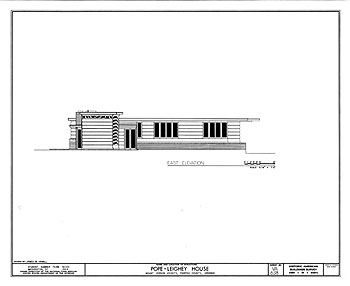
Continue, additional images...Date: 1964 Title: Pope-Leighey House 1964. Set of fifteen photographs.
Description: Frank Lloyd Wright designed this house, which was built in 1940 for Loren B. Pope. Mr. And Mrs. Robert A. Leighey purchased the home in 1946. In December 1963 Mrs. Leighey was notified that her home was in danger of demolition for a highway right-of-way in Falls Church, Fairfax County. In July 1964, she signed an agreement with the National Trust to save the home. Dismantling of the home began in the fall of 1964, reconstruction was completed in June 1965. She resumed residency of the home in July 1969. Photographed by Jack E. Boucher. Courtesy of The Library of Congress. Continue, additional images...
Size: 8 x 10 B&W photographs.
S#: 1596.53.0715 1-15
Continue, additional images...
Date: 1964 Title: Loren B. Pope House, Historic American Buildings Survey (HABS) (Published by the National Park Service, Washington, D.C.)
Author: Myer, Donald B.
Description: Photographs and Written Historical and Descriptive Data. "The Loren B. Pope House is an example of a Usonian House as designed by Frank Lloyd Wright in 1940. This represents the architect's efforts in low priced housing. It is one of the few buildings in the Washington, D. C, area by this architect. The Loren B. Pope House was built in 1940 in Falls Church, Virginia, a suburb of Washington, D. C, by Loren Pope, a newspaperman. The building has been continuously occupied as a residence since its completion. In 1964 a State condemnation suit was filed against the house to make way for interstate highway 66, Through efforts of the owner, Mrs. Robert Leighey and the assistance of the National Park Service, attempts were launched, at the time of this writing, to disassemble and move the house to another site as a permanent monument to the architect, Frank Lloyd Wright." Also includes a list of captions for the drawings and photographs. (Sweeney 2092)
Size: 8.5 x 11
Pages: Pp 9
S#: 1596.54.0815
Date: 1965
Title: Loren B. Pope Residence, Falls Church, Va. 1965 (1939 - S.268).
Description: 1) Set of eight 35mm color slides. Distant view of the Pope Residence from the Southeast. Designed by Frank Lloyd Wright in 1939. Photographed just after the completion of the 1964-5 move. The move to Mt Vernon was begun in 1964, completed in June 1965. Porch has not yet been screened in. Text on sleeve: "Wright, F. L. - Pope-Leighey House , 4-1. Pope-Leighey House. Ext., distant view. Mount Vernon, VA, USA. 1939. Wright, Frank Lloyd. U of Virginia FAIC." Acquired from the archives of the University of Virginia.
Size: 35mm Color slide, sandwiched between glass, plastic mount.
S#: 1628.99.0121 -1Date: 1965
Title: Loren B. Pope Residence, Falls Church, Va. 1965 (1939 - S.268).
Description: 2) Set of eight 35mm color slides. View of the Pope Residence from the West. The entrance is in the center. Designed by Frank Lloyd Wright in 1939. Photographed just after the completion of the 1964-5 move. The move to Mt Vernon was begun in 1964, completed in June 1965. Porch has not yet been screened in. Text on sleeve: "Wright, F. L. - Pope-Leighey House , 4-4. Pope-Leighey House. Ext., view of entrance. Mount Vernon, VA, USA. 1939. Wright, Frank Lloyd. U of Virginia FAIC." Acquired from the archives of the University of Virginia.
Size: 35mm Color slide, sandwiched between glass, plastic mount.
S#: 1628.99.0121 -2Date: 1965
Title: Loren B. Pope Residence, Falls Church, Va. 1965 (1939 - S.268).
Description: 3) Set of eight 35mm color slides. View of the Pope Residence from the West. The entrance is to the left. Designed by Frank Lloyd Wright in 1939. Photographed just after the completion of the 1964-5 move. The move to Mt Vernon was begun in 1964, completed in June 1965. Porch has not yet been screened in. Text on sleeve: "Wright, F. L. - Pope-Leighey House , 4-3. Pope-Leighey House. Ext., view from drive. Mount Vernon, VA, USA. 1939. Wright, Frank Lloyd. U of Virginia FAIC." Acquired from the archives of the University of Virginia.
Size: 35mm Color slide, sandwiched between glass, plastic mount.
S#: 1628.99.0121 -3Date: 1965
Title: Loren B. Pope Residence, Falls Church, Va. 1965 (1939 - S.268).
Description: 4) Set of eight 35mm color slides. Detailed view of the Pope Residence, brickwork and cypress. Designed by Frank Lloyd Wright in 1939. Photographed just after the completion of the 1964-5 move. The move to Mt Vernon was begun in 1964, completed in June 1965. Text on sleeve: "Wright, F. L. - Pope-Leighey House , 4-16. Pope-Leighey House. Ext., detail of brickwork. Mount Vernon, VA, USA. 1939. Wright, Frank Lloyd. U of Virginia FAIC." Acquired from the archives of the University of Virginia.
Size: 35mm Color slide, sandwiched between glass, plastic mount.
S#: 1628.99.0121 -4Date: 1965
Title: Loren B. Pope Residence, Falls Church, Va. 1965 (1939 - S.268).
Description: 5) Set of eight 35mm color slides. View of the Pope Residence from the Southeast. The perforated light screen on the left are in the living room. The glass floor to ceiling doors in the center are in the dining room, and the bedroom wing is on the right. The terrace just outside the dining room has not been completed. Designed by Frank Lloyd Wright in 1939. Photographed just after the completion of the 1964-5 move. The move to Mt Vernon was begun in 1964, completed in June 1965. Text on sleeve: "Wright, F. L. - Pope-Leighey House , 4-7. Pope-Leighey House. Ext., terrace and bedroom wing. Mount Vernon, VA, USA. 1939. Wright, Frank Lloyd. U of Virginia FAIC." Acquired from the archives of the University of Virginia.
Size: 35mm Color slide, sandwiched between glass, plastic mount.
S#: 1628.99.0121 -5Date: 1965
Title: Loren B. Pope Residence, Falls Church, Va. 1965 (1939 - S.268).
Description: 6) Set of eight 35mm color slides. View of the Pope Residence from the East. The living room is on the left. The glass floor to ceiling doors on the right is the dining room, and the bedroom wing is on the far right. The terrace just outside the dining room has not been completed. Designed by Frank Lloyd Wright in 1939. Photographed just after the completion of the 1964-5 move. The move to Mt Vernon was begun in 1964, completed in June 1965. Text on sleeve: "Wright, F. L. - Pope-Leighey House , 4-13. Pope-Leighey House. Ext., terrace and bedroom wing. Mount Vernon, VA, USA. 1939. Wright, Frank Lloyd. U of Virginia FAIC." Acquired from the archives of the University of Virginia.
Size: 35mm Color slide, sandwiched between glass, plastic mount.
S#: 1628.99.0121 -6Date: 1965
Title: Loren B. Pope Residence, Falls Church, Va. 1965 (1939 - S.268).
Description: 7) Set of eight 35mm color slides. View of the Pope Residence from the North. The bedroom wing is in the foreground. The front entrance is under the cantilevered room in the background on the right. Note the large tree just to the left. It still remains. There is a similar photograph dated 1965, with the tree removed and remnants of the stump, published in Frank Lloyd Wright’s Pope-Leighey House, Reiss, 2014, p.100. Designed by Frank Lloyd Wright in 1939. Photographed just after the completion of the 1964-5 move. The move to Mt Vernon was begun in 1964, completed in June 1965. Text on sleeve: "Wright, F. L. - Pope-Leighey House , 4-10. Pope-Leighey House. Ext., bedroom wing. Mount Vernon, VA, USA. 1939. Wright, Frank Lloyd. U of Virginia FAIC." Acquired from the archives of the University of Virginia.
Size: 35mm Color slide, sandwiched between glass, plastic mount.
S#: 1628.99.0121 -7Date: 1965
Title: Loren B. Pope Residence, Falls Church, Va. 1965 (1939 - S.268).
Description: 8) Set of eight 35mm color slides. View of the Pope Residence from the Northwest. The bedroom wing is on the left. The front entrance is under the cantilevered room in the center, and the sanctum is on the right. Designed by Frank Lloyd Wright in 1939. Photographed just after the completion of the 1964-5 move. The move to Mt Vernon was begun in 1964, completed in June 1965. Text on sleeve: "Wright, F. L. - Pope-Leighey House , 4-2. Pope-Leighey House. Ext., view from driveway. Mount Vernon, VA, USA. 1939. Wright, Frank Lloyd. U of Virginia FAIC." Acquired from the archives of the University of Virginia.
Size: 35mm Color slide, sandwiched between glass, plastic mount.
S#: 1628.99.0121 -8Date: 1965
Title: 1) Pope-Leighey House Exterior 1965 (S.268 - 1939).
Description: Set of 10 B&W photographs of the Pope-Leighey House. Designed by Frank Lloyd Wright in 1939 for Loren B. Pope, it was completed in 1940. In 1946, the home was sold to Mr. And Mrs. Robert A. Leighey. In December 1963 Mrs. Leighey was notified that her home was in danger of demolition for a highway right-of-way in Falls Church, Fairfax County. In July 1964, she signed an agreement with the National Trust to save the home. Dismantling of the home began in the fall of 1964, reconstruction was completed in June 1965. She did not resumed residency of the home until July, 1969. Photographed just after the completion of the move, but before Mrs. Leighey moved back in. Viewed from the Southwest. The Entrance is on the far left. The Sanctum (office) is on the left, The Work Space is in the center, the Living Room is on the right. This was photographed before the patio was leveled off and the Porch was screened in. Hand written on paper sleeve: "Wright House. Aug 65. TXS-D76. 5 "Da-Y."
Size: Original 4 x 5 B&W negative and 8 x 10 B&W photograph.
S#: 1628.70.0120-1Date: 1965
Title: 2) Pope-Leighey House Exterior 1965 (S.268 - 1939).
Description: Set of 10 B&W photographs of the Pope-Leighey House. Designed by Frank Lloyd Wright in 1939 for Loren B. Pope, it was completed in 1940. In 1946, the home was sold to Mr. And Mrs. Robert A. Leighey. In December 1963 Mrs. Leighey was notified that her home was in danger of demolition for a highway right-of-way in Falls Church, Fairfax County. In July 1964, she signed an agreement with the National Trust to save the home. Dismantling of the home began in the fall of 1964, reconstruction was completed in June 1965. She did not resumed residency of the home until July, 1969. Photographed just after the completion of the move, but before Mrs. Leighey moved back in. Viewed from the Southwest. The Entrance is to the far left. The Sanctum (office) is on the left, The Work Space is in the center, the Living Room is on the right. This was photographed before the patio was leveled off and the Porch was screened in. Hand written on paper sleeve: "Wright House. Aug 65. TXS-D76. 5 "Da-Y."
Size: Original 4 x 5 B&W negative and 8 x 10 B&W photograph.
S#: 1628.70.0120-2Date: 1965
Title: 3) Pope-Leighey House Living Room 1965 (S.268 - 1939).
Description: Set of 10 B&W photographs of the Pope-Leighey House. Designed by Frank Lloyd Wright in 1939 for Loren B. Pope, it was completed in 1940. In 1946, the home was sold to Mr. And Mrs. Robert A. Leighey. In December 1963 Mrs. Leighey was notified that her home was in danger of demolition for a highway right-of-way in Falls Church, Fairfax County. In July 1964, she signed an agreement with the National Trust to save the home. Dismantling of the home began in the fall of 1964, reconstruction was completed in June 1965. She did not resumed residency of the home until July, 1969. Photographed just after the completion of the move, but before Mrs. Leighey moved back in. Viewed from the dining area toward the Living Room. Built-in seating is on the far left, cushions have not yet been reinstalled. Built-in shelving is on the far wall. The table to the right was designed by Wright, and is built-in. The chair and stool in the center were designed by Wright, cushions have not yet been reinstalled. The doors on the right lead out to the screened in terrace, not yet completed. Hand written on paper sleeve: "Wright House. Aug 65. TXS-D76. 5 "Da-Y."
Size: Original 4 x 5 B&W negative and 8 x 10 B&W photograph.
S#: 1628.70.0120-3Date: 1965
Title: 4) Pope-Leighey House Living Room 1965 (S.268 - 1939).
Description: Set of 10 B&W photographs of the Pope-Leighey House. Designed by Frank Lloyd Wright in 1939 for Loren B. Pope, it was completed in 1940. In 1946, the home was sold to Mr. And Mrs. Robert A. Leighey. In December 1963 Mrs. Leighey was notified that her home was in danger of demolition for a highway right-of-way in Falls Church, Fairfax County. In July 1964, she signed an agreement with the National Trust to save the home. Dismantling of the home began in the fall of 1964, reconstruction was completed in June 1965. She did not resumed residency of the home until July, 1969. Photographed just after the completion of the move, but before Mrs. Leighey moved back in. View of the Living Room. Built-in seating is on the left, cushions have not yet been reinstalled. Built-in shelving is on the far wall and wraps around the outside corner. The chair and stool in the center were designed by Wright, cushions have not yet been reinstalled. Perforated Light Screens create patterns and add soft light to the interior of the Living Room. Hand written on paper sleeve: "Wright House. Aug 65. TXS-D76. 5 "Da-Y."
Size: Original 4 x 5 B&W negative and 8 x 10 B&W photograph.
S#: 1628.70.0120-4Date: 1965
Title: 5) Pope-Leighey House Living Room Fireplace 1965 (S.268 - 1939).
Description: Set of 10 B&W photographs of the Pope-Leighey House. Designed by Frank Lloyd Wright in 1939 for Loren B. Pope, it was completed in 1940. In 1946, the home was sold to Mr. And Mrs. Robert A. Leighey. In December 1963 Mrs. Leighey was notified that her home was in danger of demolition for a highway right-of-way in Falls Church, Fairfax County. In July 1964, she signed an agreement with the National Trust to save the home. Dismantling of the home began in the fall of 1964, reconstruction was completed in June 1965. She did not resumed residency of the home until July, 1969. Photographed just after the completion of the move, but before Mrs. Leighey moved back in. View of the Living Room Fireplace. The fireplace, hearth, stairs and some of the walls were constructed of red brick. A display of the wall construction can be seen to the left, and is still on display in the house today. Hand written on paper sleeve: "Wright House. Aug 65. TXS-D76. 5 "Da-Y."
Size: Original 4 x 5 B&W negative and 8 x 10 B&W photograph.
S#: 1628.70.0120-5Date: 1965
Title: 6) Pope-Leighey House Dining Room 1965 (S.268 - 1939).
Description: Set of 10 B&W photographs of the Pope-Leighey House. Designed by Frank Lloyd Wright in 1939 for Loren B. Pope, it was completed in 1940. In 1946, the home was sold to Mr. And Mrs. Robert A. Leighey. In December 1963 Mrs. Leighey was notified that her home was in danger of demolition for a highway right-of-way in Falls Church, Fairfax County. In July 1964, she signed an agreement with the National Trust to save the home. Dismantling of the home began in the fall of 1964, reconstruction was completed in June 1965. She did not resumed residency of the home until July, 1969. Photographed just after the completion of the move, but before Mrs. Leighey moved back in. View of the Dining Room. The fireplace, hearth, stairs and some of the walls were constructed of red brick. The fireplace is to the far left. The workspace is located behind the fireplace. The Entryway is up the stairs to the left of the dining room table. The ceiling drops to a height of 7 feet in the Dining Room. Shelves are cantilevered out from the brick wall secured by steel. Three smaller Wright designed, square, freestanding tables are combined to create the Dining Room Table. The Dining Room chairs were designed by Wright, and used in many of the Usonian homes. Cushions have not yet been reinstalled. The doors open outward to a terrace. Hand written on paper sleeve: "Wright House. Aug 65. TXS-D76. 5 "Da-Y."
Size: Original 4 x 5 B&W negative and 8 x 10 B&W photograph.
S#: 1628.70.0120-6Date: 1965
Title: 7) Pope-Leighey House Dining Room 1965 (S.268 - 1939).
Description: Set of 10 B&W photographs of the Pope-Leighey House. Designed by Frank Lloyd Wright in 1939 for Loren B. Pope, it was completed in 1940. In 1946, the home was sold to Mr. And Mrs. Robert A. Leighey. In December 1963 Mrs. Leighey was notified that her home was in danger of demolition for a highway right-of-way in Falls Church, Fairfax County. In July 1964, she signed an agreement with the National Trust to save the home. Dismantling of the home began in the fall of 1964, reconstruction was completed in June 1965. She did not resumed residency of the home until July, 1969. Photographed just after the completion of the move, but before Mrs. Leighey moved back in. View of the Dining Room. The fireplace, hearth, stairs and some of the walls were constructed of red brick. The fireplace is to the far left. The workspace is located behind the fireplace. The Entryway is up the stairs to the left of the dining room table. The ceiling drops to a height of 7 feet in the Dining Room. Shelves are cantilevered out from the brick wall secured by steel. Three smaller Wright designed, square, freestanding tables are combined to create the Dining Room Table. The Dining Room chairs were designed by Wright, and used in many of the Usonian homes. Cushions have not yet been reinstalled. The doors open outward to a terrace. Hand written on paper sleeve: "Wright House. Aug 65. TXS-D76. 5 "Da-Y."
Size: Original 4 x 5 B&W negative and 8 x 10 B&W photograph.
S#: 1628.70.0120-7Date: 1965
Title: 8) Pope-Leighey House Dining Room 1965 (S.268 - 1939).
Description: Set of 10 B&W photographs of the Pope-Leighey House. Designed by Frank Lloyd Wright in 1939 for Loren B. Pope, it was completed in 1940. In 1946, the home was sold to Mr. And Mrs. Robert A. Leighey. In December 1963 Mrs. Leighey was notified that her home was in danger of demolition for a highway right-of-way in Falls Church, Fairfax County. In July 1964, she signed an agreement with the National Trust to save the home. Dismantling of the home began in the fall of 1964, reconstruction was completed in June 1965. She did not resumed residency of the home until July, 1969. Photographed just after the completion of the move, but before Mrs. Leighey moved back in. View of the Dining Room. The fireplace, hearth, stairs and some of the walls were constructed of red brick. The ceiling drops to a height of 7 feet in the Dining Room. The square table in the center is one of the tree tables, when combined with the other two tables, creates a larger set of three table for the dining room. The two doors forming the corner, open outward, removing the corner. The Living Room is to the right. Hand written on paper sleeve: "Wright House. Aug 65. TXS-D76. 5 "Da-Y."
Size: Original 4 x 5 B&W negative and 8 x 10 B&W photograph.
S#: 1628.70.0120-8Date: 1965
Title: 9) Pope-Leighey House Master Bedroom 1965 (S.268 - 1939).
Description: Set of 10 B&W photographs of the Pope-Leighey House. Designed by Frank Lloyd Wright in 1939 for Loren B. Pope, it was completed in 1940. In 1946, the home was sold to Mr. And Mrs. Robert A. Leighey. In December 1963 Mrs. Leighey was notified that her home was in danger of demolition for a highway right-of-way in Falls Church, Fairfax County. In July 1964, she signed an agreement with the National Trust to save the home. Dismantling of the home began in the fall of 1964, reconstruction was completed in June 1965. She did not resumed residency of the home until July, 1969. Photographed just after the completion of the move, but before Mrs. Leighey moved back in. View of the Master Bedroom. The walls and ceiling are finished in Tidewater Red Cypress. A built-in desk is to the right, and the chair is Wright designed. The vase setting on the desk appeared in a photograph published in Historic Preservation, April-September, 1969, p.118. Hand written on paper sleeve: "Wright House. Aug 65. TXS-D76. 5 "Da-Y."
Size: Original 4 x 5 B&W negative and 8 x 10 B&W photograph.
S#: 1628.70.0120-9Date: 1965
Title: 10) Pope-Leighey House Bedroom 1965 (S.268 - 1939).
Description: Set of 10 B&W photographs of the Pope-Leighey House. Designed by Frank Lloyd Wright in 1939 for Loren B. Pope, it was completed in 1940. In 1946, the home was sold to Mr. And Mrs. Robert A. Leighey. In December 1963 Mrs. Leighey was notified that her home was in danger of demolition for a highway right-of-way in Falls Church, Fairfax County. In July 1964, she signed an agreement with the National Trust to save the home. Dismantling of the home began in the fall of 1964, reconstruction was completed in June 1965. She did not resumed residency of the home until July, 1969. Photographed just after the completion of the move, but before Mrs. Leighey moved back in. View of the Children’s Bedroom. The walls and ceiling are finished in Tidewater Red Cypress. Perforated Light Screens are turned 90 degrees and open outward. Hand written on paper sleeve: "Wright House. Aug 65. TXS-D76. 5 "Da-Y."
Size: Original 4 x 5 B&W negative and 8 x 10 B&W photograph.
S#: 1628.70.0120-10Date: 1965
Title: Pope-Leighey House 1965 (S.268 - 1939).
Description: Designed by Frank Lloyd Wright in 1939 for Loren B. Pope, it was completed in 1940. In 1946, the home was purchased by Mr. And Mrs. Robert A. Leighey. In December 1963 Mrs. Leighey was notified that her home was in danger of demolition for a highway right-of-way in Falls Church, Fairfax County. In July 1964, she signed an agreement with the National Trust to save the home. Dismantling of the home began in the fall of 1964, reconstruction was completed in June 1965. She resumed residency of the home in July 1969. Photographed after the completion of the move, but before Mrs. Leighey moved back in. Most likely Mrs. Leighey in the photograph. Caption on verso: "Completed exterior as viewed from entrance road seems a natural outgrowth of surrounding countryside." Stamped on Verso: "Oct 3 1965."
Size: Original 10 x 8 B&W photograph.
S#: 1628.55.0517Date: 1969
Title: The Loren Pope House, Frank Lloyd Wright (Soft Cover, Spiral Bound) (Published by The Frank Lloyd Wright Foundation, Scottsdale, Arizona, Spring Green, Wisconsin. Printed single sided.)
Author: Wright, Frank Lloyd; Pope, Loren; Peters, William Wesley
Description: Copies of documentation of correspondence between Loren Pope and Frank Lloyd Wright from 1939 through 1949, printed single sided, spiral bound.
August 18, 1939. “Dear Mr. Wright. There are certain things a man wants a during life, and, of life. Material things and things of the spirit. The writer has one fervent wish that includes both. It is a house created by you...”
Thus begins the correspondence between Loren Pope and Frank Lloyd Wright. Included are copies of 62 documents which include: Letters; Responses; Requests; Questions; Problems; Arrangements; Notes; Five Page Paper, “Dwelling for Mr. And Mrs. Loren Pope” by Frank Lloyd Wright; Estimated Costs; Bids; Contract; Architect’s Certificates; Praise; Request for a Second House. The last letter from Loren Pope to Frank Lloyd Wright is dated May 31, 1949.
The final document: “The Story of the Loren Pope House. "The house of moderate cost is not only America's major architectural problem but the problem most difficult for her major architects. As for me I would rather solve it with satisfaction to myself and Usonia, than build anything I can think of...” Frank Lloyd Wright, 1938. This final document was written by William Wesley Peters. (Circa 1965).
Size: 8.5 x 14
Pages: Pp 98
S#: 1803.29.0522
Left: Title Page
Right: August 18, 1939. “Dear Mr. Wright. There are certain things a man wants a during life, and, of life. Material things and things of the spirit. The writer has one fervent wish that includes both. It is a house created by you...” Thus begins the correspondence between Loren Pope and Frank Lloyd Wright.Date: 1969 Title: Pope-Leighey House, 1969. Set of twelve photographs of the Pope-Leighey House.
Description: Frank Lloyd Wright designed this house, which was built in 1940 for Loren B. Pope. Mr. And Mrs. Robert A. Leighey purchased the home in 1946. In December 1963 Mrs. Leighey was notified that her home was in danger of demolition for a highway right-of-way in Falls Church, Fairfax County. In July 1964, she signed an agreement with the National Trust to save the home. Dismantling of the home began in the fall of 1964, reconstruction was completed in June 1965. She resumed residency of the home in July 1969. Photographed by Jack E. Boucher after after the house was dismantled, moved reconstruction. Courtesy of The Library of Congress. Continue, additional images...
Size: Original 8 x 10 B&W Photographs.
S#: 1803.15.0715 1-12
Continue, additional images...
Date: April - September 1969 Publication: Historic Preservation
Author: Bullock, Helen Dudpry & Morton, Terry B.
Description: The Pope-Leighey House. Special issue on the Pope-Leighey House. Whole issue devoted specific to this Wright House. This was later re-issued as a book, see S#1760. (Sweeney 1790)
Size:
Pages: Pp 120
S#: 1790.00.0404
Date: 1969 Publication: The Pope-Leighey House
Author: Bullock, Helen Dudpry & Morton, Terry B. Contributing editors: Brooks, H. Allen; Pop, Loren B.; Leighey, Marjorie F.; Chadwick, Gordon; Rickert, Howard C.; Watterson, Joseph; Pearce, John N.; Morton, Terry B.; Kaufmann, Edgar J. Jr.
Description: An exact reprint of Historic Preservation - April -September 1969. Only difference is the cover. (First Edition) (Sweeney 1760)
Size:
Pages: Pp 120
S#: 1760.00.0102Date: 1970 Title: Pope-Leighey House Circa 1970, viewed from the West.
Description: There are a few details that place this photograph close to the 1969 images, but at a later date. Damage to the fascia , about 2-3 feet from the Western corner is consistent with 1969. The screened Terrace is missing the screen, as is evident in 1969, #6. Details that place it at a little later date: mature plants, oil stains on the drive and the mail box. These and the cat at the entrance would indicate that Mrs. Leighey is now living in the home. Also in the Chadwick interview published in 1969, he says "I also feel that the screened porch and terrace must be rebuilt." P.75. It is interesting to note that although Wright’s original plans included the design for the screen, it had not been built when it was published in The Natural House, 1954. Courtesy of the State of Virginia.
Size: 10 x 7 B&W photograph.
S#: 1846.28.0915
Date: 1977 Publication: Brochure: The Pope-Leighey House
Description: “The Pope-Leighey House. A Property of The National Trust for Historical Preservation in the United States.” Produced by The National Trust for Historical Preservation History and information about the home. Includes six photographs and two illustrations.
Size: 4 x 9.3
Pages: Pp 8
S#: 2033.01.0707
Date: 1983 Reprint Publication: The Pope-Leighey House
Author: Morton, Terry B.; Contributing editors: Brooks, H. Allen; Pop, Loren B.; Leighey, Marjorie F.; Chadwick, Gordon; Rickert, Howard C.; Watterson, Joseph; Pearce, John N.; Morton, Terry B.; Kaufmann, Edgar J. Jr.
Description: Many changes throughout this edition. Bullock dropped as co-editor. (First Edition of Second Printing)
Size:
Pages: Pp 120
ST#: 1983.13.0105
Date: Circa 1988
Title: Loren B. Pope Residence, Circa 1988 (1939 - S.268).
Description: Designed in 1939, construction was completed during the early part of 1941. The Popes lived in the home until 1947 when they sold the home to Mr. & Mrs. Leighey. The house was slated for destruction by the highway department, and Mrs. Leyhey saved the house by having it moved to the grounds of Woodlawn Plantation, a National Trust property. Printed on a toothed paper stock from an original pen and ink stippling drawing by Rachael A Peden. The original 20 x 24 inch pen and ink stippling drawing was created at the request of the National Trust. Gift of Kathryn Smith.
Size: Original 11 x 14 offset lithography print.
ST#: 1988.117.0321Date: 1989 Title: Pope-Leighey Residence 1989 (S.268 - 1939).
Description: Caption on face: (June 15) Wright House Threatened - Architect and designer Frank Lloyd Wright’s Pope-Leighey house, built in 1940 and named for its first and second owner’s is threatened by shifting ground in Mount Vernon, Virginia, only 25 years after it was saved from destruction by highway construction. The house, relocated in 1964 by the National Trust for Historic Preservation, was rebuilt on a seam of highly unstable clay and experiencing cracks throughout its structure. (AP) Acquired from the archived of the Chicago Tribune.
Size: Original 8.5 x 6.5 B&W photograph.
ST#: 1989.83.1012
Date: 1993 Title: Living Museums (Hard Cover - DJ)
Author: Gale, Ian & Bryant, Richard
Description: Chapter 5: Pope-Leighey Residence. Original HC List Price $40.00. (First Edition)
Size:
Pages: Pp 36-41
ST#: 1993.15.0596
Date: 1996 Publication: Pope-Leighey House (Published by the National Trust for Historic Preservation)
Author: Pretzer, Michael
Description: Adapted from an article by Pretzer which originally appeared in the March/April 1994 Historic Preservation. Includes 3/4" removable banner wrap. Original SC List Price $6.50. (First Edition)
Size: 4.5 x 8
Pages: Pp 16
ST#: 1996.48.0406
Date: 1996 Title: Pope-Leighey House Post Card. WLP 101. Published by C. Harrison Conroy Co. Charlotte, NC.
Description: Frank Lloyd Wright’s Pope-Leighey House (1940). (Two Cards)
Size: 3.5 x 5.
ST#: 1996.49.0406, 1996.50.0406
Date: 1996 Title: Pope-Leighey House Post Card. WLP 102. Published by C. Harrison Conroy Co. Charlotte, NC.
Description: Frank Lloyd Wright’s Pope-Leighey House (1940). (Two Cards)
Size: 3.5 x 5
ST#: 1996.51.0406, 1996.52.0406
Date: 1996 Title: Pope-Leighey Residence Restoration 1996 (S.268 - 1939).
Description: Caption on face: "March 31 1996 – Pam pierce and her husband, Kendall, from Pierce Cabinetry of South Carolina, are seen from the roof of the Original Pope-Leighey House checking blue prints for the soon-to-be-restored version of the house while Rick Wightman works on its roof March 27, 1996 in Mount Vernon, Va. More than 50 years after it was built, the Pope-Leighey house is falling apart through no fault of its architect, Frank Lloyd Wright. To save it, the home’s benefactors say they must dismantle, move and rebuild the structure, and forever alter Wright’s design in the process. (AP Photo/Rick Bethem)." Clipping pasted to verso: "People will go to great lengths to save a Frank Lloyd Wright house. In Mt. Vernon, Va., for example, benefactors are dismantling the Pope-Leighey House. The house, designed by Wright, fell into disrepair, so people like Pam and Kendal Pierce of South Carolina (checking blueprints) are helping to dismantle and rebuild it on a different lot. The move will change the design somewhat." Stamped on clipping: "Apr 13 96". Acquired from the archived of the Chicago Tribune.
Size: Original 9.75 x 6.5 B&W photograph.
ST#: 1996.68.0811
Date: 2006 Title: Pope-Leighey House 2006. Set of eight photographs of the Pope-Leighey House, by Douglas M. Steiner, April 7, 2006.
Description: As you approach the home from the same direction as in 1939, the Carport, it has been positioned on a slope much like the original. Like many of Wright's designs, the entrance is hidden, and is not revealed until you reach the home. The lack of windows on the approach reveals little of the interior of the home. Perforated Light Screens allow soft light into the home, adding a measure of privacy and a decorative design element to the home. The roof of the Carport cantilevers out 8' 6" at the front, is 19' wide, and cantilevers out from the house 15' 6" in the back. The roof was designed with three layers of 2x4's, each superimposed on top of the other. The Perforated Light Screens... Continue, additional images...
Size: Original 10 x 7.5 High Res digital color photographs.
ST#: 2006.44.0815 1-8
Continue, additional images...
Date: 2014
Title: Frank Lloyd Wright’s Pope-Leighey House (Hard Cover DJ) (Published by the University of Virginia Press, Charlottesville and London)
Author: Reiss, Steven M.
Description: Frank Lloyd Wright designed and realized over 500 buildings between 1886 and 1959 for a wide range of clients. In Frank Lloyd Wright's Pope-Leighey House, architect Steven M. Reiss presents the updated and detailed story of one of Wright’s few Virginia commissions. Designed and built for Loren and Charlotte Pope and later purchased by Marjorie and Robert Leighey, the Pope-Leighey House stands as a stunning example of an innovative form of shelter—which Wright called Usonian—for families beset by the Great Depression. Here, and elsewhere, Wright offered a unique and unprecedented approach for homes that would be small yet architecturally significant, carefully sited, and constructed of readily available local materials. He believed that anyone with an acre of land should have the opportunity to own a Usonian home. Set in Northern Virginia, the Pope-Leighey House has an unusual history in that it has been moved twice, first to the grounds of the National Trust’s Woodlawn to rescue it from the path of Route 66 in Falls Church, then to re-site it to better correspond to its original orientation. Wright’s mission was to remind us that "we need to see life in simpler terms." In this amply illustrated book, Reiss echoes Wright’s reminder that small, carefully built structures should be the starting point of sustainable and environmentally responsible house design." Dust Jacket. Original list price $35.00. (First Edition)
Size: 7 x 8.25
Pages: Pp 189
ST#: 2014.43.0419Date: 2015 Title: Pope-Leighey House 2006. Set of 63 photographs of the Pope-Leighey House, by Douglas M. Steiner, April 7, 2015.
Description: Like many of Wright's Usonian homes, it was an "L" shaped design based on a 2x4 foot rectangular module. It was constructed of brick, natural unfinished cypress and glass. The home slowly rises above the ground as the ground slopes away from the home. Like many of Wright's designs, the entrance is hidden, and is not revealed until you reach the home. Four door panels make up the Entrance. The two outside panels are fixed, the two center doors are mounted... Continue, additional images...
Size: Original 11 x 7.5 High Res digital color photographs.
ST#: 2015.03.0815 1-63
Continue, additional images...
Date: 2021
Title: Pope-Leighy House, Falls Church, Virginia Model 2021(1939 - S.268).
Description: 1:64th scale Model after the Frank Lloyd Wright designed Usonian Pope-Leighy House. Designed by Frank Lloyd Wright in 1939. Construction began in May 1940 and was completed during the early part of 1941. It is "L" shaped design based on a 2x4 foot rectangular module and was constructed of brick, cypress and glass. This scale model house was built from scratch and has been flipped.
Size: 9.25 x 7.5 x 2.3.
ST#: 2021.06.0621WRIGHT STUDY
LOREN B. POPE (POPE-LEIGHEY) RESIDENCE (1939 - S.268)Introduction Floor Plan Perforated Light Screen Photographs (1940) The Natural House (1954)
Drawings HABS (1964) Photographs (1964) Photographs (1969) Photographs (1970) Photographs (2006)
Photographs (2015) Bibliography POTOMAC MAGAZINE
Introduction
In August 1939, Loren B. Pope, a journalist working for the Washington Evening Star, Wrote to Frank Lloyd Wright and asked if he would design a home for his property in Falls Church, Virginia. Two weeks later Mr. Wright responded, "Of Course I am ready to give you a house. We are expecting to see you soon..."
In a 2006 interview, Pope recalled, "In January 1938, a Time magazine article again sparked my interest in Wright and his recently published An Autobiography. I borrowed the book from the library, returned it the next day, bought my own copy and soaked up every chapter two and three times before going on to the next." National Building Museum, Reiss, 2006.
By October 1939, the preliminary sketches were ready, and Pope traveled to Taliesin to view them. He attempted to secure a loan, but every lending agency refused. He quoted one lender, "Loren, this house would be a white elephant." He finally secured a loan from his employer, the Washington Evening Star.
Construction began in May 1940, with Taliesin apprentice Gordon Chadwick overseeing the project. Construction was completed during the early part of 1941, and the Popes movedinto their new Wright designed home. They lived there for over five years until they put the home up for sale in November 1947. It sold within two weeks, and Mr. and Mrs. Robert A. Leighey moved into the home in February 1947.
Like many of Wright's Usonian homes, it was an "L" shaped design based on a 2x4 foot rectangular module. It was constructed of brick, cypress and glass.
Mr. Leighey past away in July 1963. In December of the same year, the Virginia Highway Department notified Mrs. Leighey that her home was to be condemned for a highway right-of-way in Falls Church, Fairfax County. In July 1964, she signed an agreement with the National Trust to save the home. Dismantling of the home began in the fall of 1964, reconstruction was completed in June 1965. She resumed residency of the home in July 1969.
Three decades later, the home was moved again. Structural problems began to create cracks due to the unstable soil under the home. In 1996, the home was moved 30 feet away, where it sits today.
Floor Plan
Floor plan for the Pope-Leighey House, 1939/1965. Frank Lloyd Wright designed this house, which was built in 1940 for Loren B. Pope. Mr. And Mrs. Robert A. Leighey purchased the home in 1946. In December 1963 Mrs. Leighey was notified that her home was in danger of demolition for a highway right-of-way in Falls Church, Fairfax County. In July 1964, she signed an agreement with the National Trust to save the home. Dismantling of the home began in the fall of 1964, reconstruction was completed in June 1965. She resumed residency of the home in July 1969. Courtesy of The Library of Congress, adapted by Douglas M. Steiner.
Pope Residence Perforated Light Screen
Loren B. Pope Perforated Light Screen, provide privacy and allow natural light to flood the interior.
Loren B. Pope Perforated Light Screen, adapted by Douglas M. Steiner.
Half panel Living Room Perforated Light Screen, adapted by Douglas M. Steiner. Pope Residence (1940)
This set of seven photographs of the Pope-Leighey House were taken during construction by Loren Pope in 1940. Preliminary sketches were completed in October 1939. Construction began in May 1940, with Taliesin apprentice Gordon Chadwick overseeing the project. The house was completed during the early part of 1941.
After the footings were poured, a row of bricks was laid around the edge. Two-inch iron pipe coils for the radiant heat were placed on a bed of crushed rock, and embedded in the concrete slab. "Radiant heating was a virtually unknown thing at that time. Everybody thought we were crazy to lay wrought iron pipes under the floor. They kept asking, ‘What if there is a leak? You would have to dig up the whole slab.' However, all the pipes were tested for almost a week at approximately 120 pounds of pressure.The normal operating pressure of the system is only 11 pounds..." Gordon Chadwick, apprentice assigned to the construction of the Pope house. The Pope-Leighey House, Morton, 1969, p.75.
Once the concrete pad was poured, a 2 x 4 foot grid was scribed in the concrete. Inspectors would not approve Wright's innovative sandwich wall, so they set up a test. "The experiment was conducted in Falls Church before attempting to convince the building inspectors in Baltimore, where the Joseph Euchtman House was also under construction, that the innovative sandwich wall without struts could bear the required load." P.78.
The Popes moved into the home during the early part of 1941. All photographs by Loren Pope. Courtesy of the William Edmund Barrett collection.
1) Loren B. Pope Residence Fall 1940. Viewed from the Southwest, from the Entry toward the Living Room. The footings have been poured, and the row of bricks that borders the slab has been laid. Two-inch iron pipe coils for the radiant heat are placed on a bed of crushed rock, and will be embedded in the concrete slab. The Dining Room is on the left, the Living Room is in the center background, the exterior screened Terrace is on the right. The Bedroom wing is to the left, the Kitchen to the far right. "Radiant heating was a virtually unknown thing at that time. Everybody thought we were crazy to lay wrought iron pipes under the floor. They kept asking, ‘What if there is a leak? You would have to dig up the whole slab.' However, all the pipes were tested for almost a week at approximately 120 pounds of pressure. The normal operating pressure of the system is only 11 pounds..." Gordon Chadwick, apprentice assigned to the construction of the Pope house. The Pope-Leighey House, Morton, 1983, p.75. 10 x 8 B&W photograph. Courtesy of the William Edmund Barrett collection. (S#0531.47.0815-1) 2) Loren B. Pope Residence Fall 1940. Viewed from the West, from the Master Bedroom. Workmen are putting the finishing touches on the concrete slab. The 2 x 4 foot grid has been scribed in the concrete. The pad was bordered with a row of bricks. The Living Room is on the left. The Dining Room is in the foreground. The Fireplace is in the center, the Kitchen is to its right. The screened Terrace is in the background. The Entrance is to the right. 10 x 6 B&W photograph. Courtesy of the William Edmund Barrett collection. (S#0531.47.0815-2) 3) Loren B. Pope Residence Fall 1940. The Living Room viewed from the North. Completion of the masonry walls. The Living Room is in the foreground on the left, Fireplace and Kitchen in the center, Dining Room on the right. Stairs leading up to the Entrance are complete. The Pope-Leighey House, Morton, 1983, p.82. 10 x 6 B&W photograph. Courtesy of the William Edmund Barrett collection. (S#0531.47.0815-3) 4) Loren B. Pope Residence Fall 1940. The office viewed from the Southeast. "A wall section undergoing tests in 1940. The experiment was conducted in Falls Church before attempting to convince the building inspectors in Baltimore, where the Joseph Euchtman House was also under construction, that the innovative sandwich wall without struts could bear the required load." Caption, The Pope-Leighey House, Morton, 1983, p.78. 8 x 10 B&W photograph. Courtesy of the William Edmund Barrett collection. (S#0531.47.0815-4) 5) Loren B. Pope Residence Fall 1940. The Entry and Office viewed from the West. I-beams for supporting the carport roof are in place. The Office wall section is undergoing a test. "The experiment was conducted in Falls Church before attempting to convince the building inspectors in Baltimore, where the Joseph Euchtman House was also under construction, that the innovative sandwich wall without struts could bear the required load." The Pope-Leighey House, Morton, 1983, p.78. 10 x 5.75 B&W photograph. Courtesy of the William Edmund Barrett collection. (S#0531.47.0815-5) #6 6) Loren B. Pope Residence 1940. Viewed from the West during construction. The Bedroom wing is to the left, Entrance and Office to the right. The Perforated Light Screens have yet to be installed. 10 x 6 B&W photograph. Courtesy of the William Edmund Barrett collection. (S#0531.47.0815-6) 7) Loren B. Pope Residence 1940. Viewed from the North during construction. The Living Room is on the left, Dining in the center and Bedroom wind on the right. The windows and doors appear to be installed, but the Perforated Light Screens in the Living Room have not. 10 x 6 B&W photograph. Courtesy of the William Edmund Barrett collection. (S#0531.47.0815-7) Pope Residence - The Natural House (1954)
Frank Lloyd Wright published The Natural House, Horizon Press, in 1954. He included four drawings and photographs. The estimates to build Wright's preliminary drawings shown here, were to expensive on Pope's salary of $50 per week, so Wright redesigned and reduced he size of the home. The average cost of a new house in 1940 was $3,920. Initial estimates for Pope came in at $12,000, new estimates for the revised plan was reduced to $7,000, 1,800 to 1,200 square feet. Wright published the price of $8,000 in The Natural House.
In Wright's preliminary sketch of the Loren B. Pope House, he included a "Lantern" above the Master and a portion of the Children's Rooms which included clerestory Perforated Light Screens. To the left of the bedroom wing the "Grass Terrace"was enclosed by a thick hemicycle row of foliage. The original entry was a single door, hidden under the Carport, tucked next to the Utility Room and Shop. The Shop was also eliminated. The screened Terrace, was also reduced.
Although the two photographs were published in 1954, the landscape appears closer to the landscape in the 1940 #6 image. Landscaping appears incomplete, and there are stumps next to the Carport. The built-in planter on the left appears to be empty. The screened Terrace has yet to be screened. Construction began in May 1940, the Pope's moved into the early part of 1941. Possibly photographed during a late snowfall in March-April 1941 or during the winter of 1941-42.
1) Preliminary sketch of the Loren B. Pope House, Falls Church, Virginia. In the center foreground, this original sketch included a "Lantern" above the Master and a portion of the Children's Rooms which included clerestory Perforated Light Screens, allowing additional light and ventilation into the rooms. To the left of the bedroom wing the "Grass Terrace" was enclosed by a thick hemicycle row of foliage. The original entry was a single door, hidden under the Carport, tucked next to the Utility Room and Shop. The Shop was also eliminated. The screened Terrace, was also reduced. Courtesy of The Natural House, Horizon Press, 1954. 2) Loren B. Pope Preliminary Floor Plan. Courtesy of The Natural House, Horizon Press, 1954. Revised and reduced Floor Plan for the Pope House. It was reduced from the initial square footage of 1,800 to 1,200 square feet. Note: we have reduced and rotated the floor plan so it can be compared to the original Preliminary Floor Plan. Adapted by Douglas M. Steiner. 3) Viewed from the Southwest, circa 1941. Although published in 1954, the landscape appears closer to the landscape in the 1940 #6 image. Landscaping appears incomplete, and there are stumps next to the Carport. The built-in planter on the left appears to be empty. Construction began in May 1940, the Pope's moved into the early part of 1941. Possibly photographed during a late snowfall in March-April 1941 or during the winter of 1941-42. The two bedrooms are in the foreground wing on the left. The row of Perforated Light Screen windows that run the length of the Gallery, allow light in and also a measure of privacy. The Entrance, Carport and Office are to the right. Courtesy of The Natural House, Horizon Press, 1954. Possibly photographed by Hedrich-Blessing. 4) Viewed from the South, circa 1941. Although published in The Natural House, 1954, it appears to be photographed at the time as the image above (#3). Possibly photographed during a late snowfall in March-April 1941 or during the winter of 1941-42. The built-in planter on the right, just outside the Kitchen window appears to be empty. The screened Terrace on the right has yet to be screened. Construction began in May 1940, the Pope's moved into the early part of 1941. The two Bedrooms are on the left, the Carport and Entrance in the center, Office, Kitchen and Living Room are on the right. Photographed by Hedrich-Blessing. Courtesy Douglas M. Steiner. 4A) Detail of the Southwest elevation. The two Bedrooms are on the left, the Carport and Entrance in the center, the Office is on the right. 4B) Detail of the Southeast elevation. The built-in planter just outside the Kitchen window appears to be empty. The screened Terrace on the right has yet to be screened. POPE Residence Drawings HABS (1964)
Set of nine drawings of the Pope-Leighey House by the National Park Service for the Historic American Building Survey (HABS) 1964. Frank Lloyd Wright designed this house, which was built in 1940 for Loren B. Pope. An example of Wright's "Usonian House," the structure, in danger of demolition in 1965 for a highway right-of-way in Falls Church, Fairfax County, was saved, moved and restored by Mrs. Robert A. Leighey, The National Trust for Historic Preservation and The National Park Service. This important American Architectural Monument was relocated at Woodlawn Plantation, near Mount Vernon. All drawings courtesy of The Library of Congress.
Pope-Leighey Residence Photographs (1964)
Set of fifteen photographs of the Pope-Leighey House, 1964. Frank Lloyd Wright designed this house, which was built in 1940 for Loren B. Pope. Mr. And Mrs. Robert A. Leighey purchased the home in 1946. In December 1963 Mrs. Leighey was notified that her home was in danger of demolition for a highway right-of-way in Falls Church, Fairfax County. In July 1964, she signed an agreement with the National Trust to save the home. Dismantling of the home began in the fall of 1964, reconstruction was completed in June 1965. She resumed residency of the home in July 1969. There are many stereotypical Usonian details designed into the Pope Residence. It was constructed of brick, unfinished cypress and glass. Natural unfinished cypress siding runs horizontally. The cantilevered carport extends out over the Entrance to the home. Perforated Light Screens allow soft light into the home, and add a measure of privacy. Wright designed three cantilevered trellised roofs, at the end of the Living Room, the end of the Children's Bedroom, and the Dining Room. Wright mimicked the trellised roof just above the stairs that lead down to the interior Living Room. Of interest... Continue...
Pope-Leighey Residence Photographs (1969)
Set of twelve photographs of the Pope-Leighey House, 1969. Frank Lloyd Wright designed this house, which was built in 1940 for Loren B. Pope. Mr. And Mrs. Robert A. Leighey purchased the home in 1946. In December 1963 Mrs. Leighey was notified that her home was in danger of demolition for a highway right-of-way in Falls Church, Fairfax County. In July 1964, she signed an agreement with the National Trust to save the home. Dismantling of the home began in the fall of 1964, reconstruction was completed in June 1965. She resumed residency of the home in July 1969. There are many stereotypical Usonian details designed into the Pope Residence. It was constructed of brick, unfinished cypress and glass. Natural unfinished cypress siding runs horizontally. The cantilevered carport extends out over the Entrance to the home. Perforated Light Screens allow soft light into the home, and add a measure of privacy. Wright designed three cantilevered trellised roofs, at the end of the Living Room, the end of the Children's Bedroom, and the Dining Room. Wright mimicked the trellised roof just above the stairs that lead down to the interior Living Room... Continue...
Pope-Leighey Residence (Circa 1970)
Pope-Leighey House Circa 1970, viewed from the West. There are a few details that place this photograph close to the 1969 images, but at a later date. Damage to the fascia , about 2-3 feet from the Western corner is consistent with 1969. The screened Terrace is missing the screen, as is evident in 1969, #6. Details that place it at a little later date: mature plants, oil stains on the drive and the mail box. These and the cat at the entrance would indicate that Mrs. Leighey is now living in the home. Also in the Chadwick interview published in 1969, he says "I also feel that the screened porch and terrace must be rebuilt." P.75. It is interesting to note that although Wright’s original plans included the design for the screen, it had not been built when it was published in The Natural House, 1954. Courtesy of the State of Virginia.
Pope-Leighey Residence By Douglas M. Steiner (April 2006)
In April, 2006 on a trip to Washington D. C. with our oldest grandson, we had the opportunity to visit the Pope-Leighey House. The house has rotated about 45 degrees during the 1965 reconstruction, so where the entrance faced Southwest in 1939, it now faces Northwest. But I assume that had to do with typography rather than lighting.
Ten years before our visit, the home was moved again. Structural problems began to create cracks due to the unstable soil under the home. In 1996, the home was moved 30 feet away, where it sits today.As you approach the home from the same direction as in 1939, the Carport, it has been positioned on a slope much like the original. Like many of Wright's designs, the entrance is hidden, and is not revealed until you reach the home. So you take a step of faith, not knowing where, but knowing it is there.
Very little has sprouted during the beginning of April, so the unfinished cypress blends with the bare trees. The lack of windows on the approach reveals little of the interior of the home. Perforated Light Screens allow soft light into the home, adding a measure of privacy and a decorative... Continue...
Pope-Leighey Residence By Douglas M. Steiner (April 2015)
On April 7, 2015 nine years to the day, we had the opportunity to visit the Pope-Leighey Residence for the second time, on a trip to Washington D. C. with our granddaughter.
The house has rotated about 45 degrees during the 1965 reconstruction, so where the entrance faced Southwest in 1939, it now faces Northwest. Like many of Wright's Usonian homes, it was an "L" shaped design based on a 2x4 foot rectangular module. It was constructed of brick, cypress and glass.
Nineteen years before this visit, the home was moved again. Structural problems began to create cracks due to the unstablesoil under the home. In 1996, the home was moved 30 feet away, where it sits today. Third time is a charm.
The home is situated on the Woodlawn Plantation in Mount Vernon, but so seclude in the woods that the four-lane road, only 300 feet away, is hidden from view. The colors of the unfinished cypress and bricks blends with the surroundings. Like other Usonians, the homes are built on a slap, have a flat roofs and built-in planters. The slab which the home is built on is bordered in bricks.
The home slowly rises above the... Continue...
Bibliography
"House Beautiful", August 1948, pp. 32-34, 80, 90. "The Natural House", Wright, 1954, pp 143-146. "Historic Preservation", April - September 1969 "The Pope-Leighey House", Bullock and Morton, 1969. "The Decorative Designs of Frank Lloyd Wright", Hanks, 1979, pp. 156-160. "Writings on Wright", Brooks, 1981, pp. 51, 52-57, 59-63, 65-68, 186, 223 "Frank Lloyd Wright Monograph 1937-1941", Vol. 6, Text: Pfeiffer; Edited and Photographed: Futagawa, 1990, pp 162-169. "Frank Lloyd Wright Remembered", Meehan, 1991, pp.65-75, 140-47. "Frank Lloyd Wright Selected Houses 6", Pfeiffer, 1991, pp.78-91. "Architectural Monographs No 18: Frank Lloyd Wright", Heinz, 1992, p.102-103. "The Wright Style", Lind, 1992, pp. 112-113, 120 "The Frank Lloyd Wright Companion", Storrer, 1993, p 276. "Living Museums", Gale and Bryant, 1993, pp.36-41 "Frank Lloyd Wright, East", Heinz, 1994, pp.38-43. "Pope-Leighey House", Pretzer, 1996. "Frank Lloyd Wright’s Interiors", Heinz, 2002, p 62 "Frank Lloyd Wright Usonian Houses GA Traveler 005", Pfeiffer, 2002, pp.176-197 "Usonian Houses: Frank Lloyd Wright At A Glance", Ehrlich, 2002, pp.4, 6, 8-9, 40, 48-53. POTOMAC MAGAZINE Date: 1968
Title: Potomac Magazine, Washington Post Sunday Magazine - September 8, 1968 (Published weekly by the Washington Post Company, Washington D.C.)
Author: Le Sueur, Dorothy
Description: Fall Fashions. A full issue dedicated to fall fashions, photographed at the Frank Lloyd Wright designed Pope-Leighey House at Woodlawn.
“...This significant casual theme recalls the 1940s, when American sportswear hit the international map with a sonic-size bang. Because of it, this section was photographed at the Pope-Leighey House, designed in 1940 by Frank Lloyd Wright. A property of the National Trust, located at Woodlawn Plantation, Mt. Vernon, Va., this small house is one of a series he called Usonian—a designation once proposed for this country by Samuel Butler. The architect felt the name defined his aim in this group of houses-to give architecture industrial advantages without imitating mansions.
Usonian is also applicable to this group of American clothes, the ideas and concepts of which emphasize that sophistication in clothes today is simplification and that common sense need not destroy individuality....”
Includes seventeen photographs in and around the Pope-Leighey house. Photography by Linda Bartlett.
Size: 10.75 x 12.75
Pages: Pp 3-44
S#: 1757.54.1024
HOME ARTIFACTS AUDIO BOOKS PERIODICALS PHOTOS POSTCARDS POSTERS STAMPS STUDIES ASSISTING ABOUT SLIDE SHOW To donate or pass on information, comments or questions:
steinerag@msn.com
©Copyright Douglas M. Steiner, 2001, 2024
